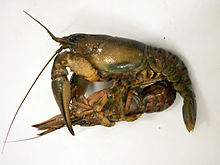| Spinycheek crayfish | |
|---|---|

| |
| Conservation status | |
 Least Concern (IUCN 3.1) | |
 Secure (NatureServe) | |
| Scientific classification | |
| Domain: | Eukaryota |
| Kingdom: | Animalia |
| Phylum: | Arthropoda |
| Class: | Malacostraca |
| Order: | Decapoda |
| Suborder: | Pleocyemata |
| Family: | Cambaridae |
| Genus: | Faxonius |
| Species: | F. limosus |
| Binomial name | |
| Faxonius limosus (Rafinesque, 1817) | |
| Synonyms | |
| |
Faxonius limosus, synonym Orconectes limosus, is a species of crayfish in the family Cambaridae. It is native to the east coast of North America, from Quebec to the lower James River, Virginia, but has also been introduced to Europe. It is known commonly as the spinycheek crayfish or Kamberkrebs in German.

It is unusual in that it lives in silty streams, rather than the clear water usually preferred by crayfish. Like Pacifastacus leniusculus, another invasive North American crayfish, F. limosus carries crayfish plague and is a threat to native European crayfish.

F. limosus was introduced to Germany in 1890, and has since spread across much of Northern Europe, recently reaching the United Kingdom. It has also spread southwards as far as the Danube in Serbia.
In Europe, F. limosus is included since 2016 in the list of Invasive Alien Species of Union concern (the Union list). This implies that this species cannot be imported, bred, transported, commercialized, or intentionally released into the environment in the whole of the European Union.

Faxonius limosus can reproduce sexually or by parthenogenesis. Lobsters and crayfish are decapods meaning that they have 10 legs. 2 of them are claws. These crayfish live on the bottom of the freshwater pools, such as lakes, ponds and swamps. They prefer flat, sandy, and rocky floors. They are also found outside the water on beaches or lawns near the pool of water. They use rocks to make burrows while in the water. This is a very common species of crayfish, especially on Northeast United States, and Southeast Canada.
References
- ^ Adams, S.; Schuster, G.A. & Taylor, C.A. (2010). "Orconectes limosus". IUCN Red List of Threatened Species. 2010: e.T153764A4541724. doi:10.2305/IUCN.UK.2010-3.RLTS.T153764A4541724.en. Retrieved 11 November 2022.
- ^ "Faxonius limosus". NatureServe Explorer An online encyclopedia of life. 7.1. NatureServe. Retrieved 11 November 2022.
- ^ Crandall, Keith A; De Grave, Sammy (2017). "An updated classification of the freshwater crayfishes (Decapoda: Astacidea) of the world, with a complete species list". Journal of Crustacean Biology. 37 (5): 615–653. doi:10.1093/jcbiol/rux070.
- "Faxonius limosus". Global Biodiversity Information Facility. Retrieved 2022-03-23.
- James W. Fetzner Jr. (December 6, 2006). "Orconectes (Faxonius) limosus (Rafinesque, 1817)". Crayfish Taxon Browser. Carnegie Museum of Natural History. Archived from the original on September 27, 2007. Retrieved August 29, 2007.
- Whitney Stocker. "Orconectes (Faxonius) limosus (Rafinesque, 1817)". Retrieved August 29, 2007.
- ^ David Holdich & John Black (2007). "The spiny-cheek crayfish, Orconectes limosus (Rafinesque, 1817) (Crustacea: Decapoda: Cambaridae), digs into the UK". Aquatic Invasions. 2 (1): 1–16. doi:10.3391/ai.2007.2.1.1.
- Bonelli, Marco; Manenti, Raoul; Scaccini, Davide (2017). "Mountain protected areas as refuges for threatened freshwater species: the detrimental effect of the direct introduction of alien species". Eco.mont (Journal on Protected Mountain Areas Research). 9 (2): 23–29. doi:10.1553/eco.mont-9-2s23. hdl:11577/3315607. ISSN 2073-106X.
- S. Pavlović; S. Milošević; S. Borković; V. Simić; M. Paunović; R. Žikić; Z. Saičić (2006). "A report of Orconectes (Faxonius) limosus (Rafinesque, 1817) (Crustacea: Deacpoda: Astacidea: Cambaridae: Orconectes: subgenus Faxonius) in the Serbian part of the River Danube". Biotechnology & Biotechnological Equipment. 20 (1): 53–56. doi:10.1080/13102818.2006.10817304.
- "List of Invasive Alien Species of Union concern - Environment - European Commission". ec.europa.eu. Retrieved 2021-07-27.
- "REGULATION (EU) No 1143/2014 of the European parliament and of the council of 22 October 2014 on the prevention and management of the introduction and spread of invasive alien species".
- M Buřič; M Hulák; A Kouba; A Petrusek; P Kozák (2011). "successful crayfish invader is capable of facultative parthenogenesis: a novel reproductive mode in decapod crustaceans". PLoS ONE. 6 (5): e20281. Bibcode:2011PLoSO...620281B. doi:10.1371/journal.pone.0020281. PMC 3105005. PMID 21655282.
![]() Media related to Faxonius limosus at Wikimedia Commons
Media related to Faxonius limosus at Wikimedia Commons
| Taxon identifiers | |
|---|---|
| Faxonius limosus | |
| Orconectes limosus |
|
| Astacus limosus | |
This crayfish article is a stub. You can help Misplaced Pages by expanding it. |